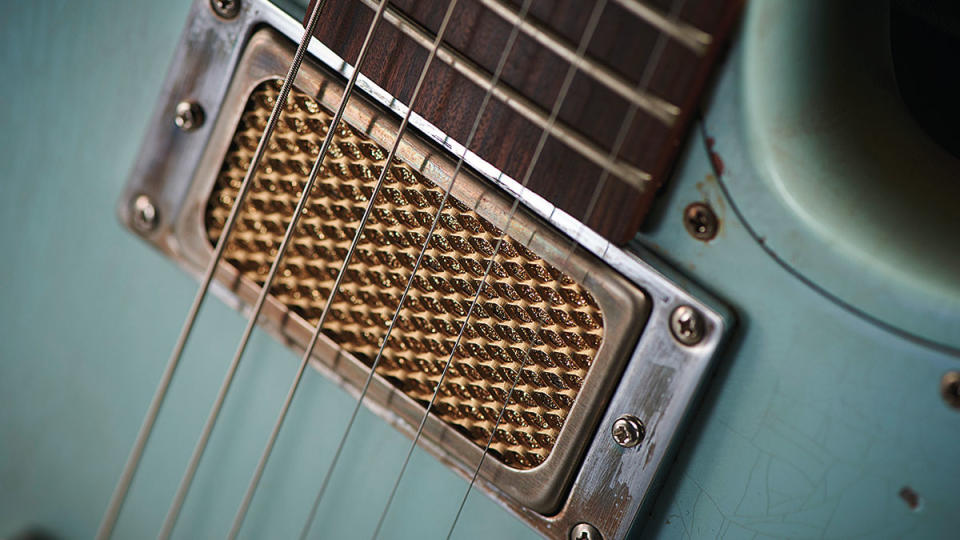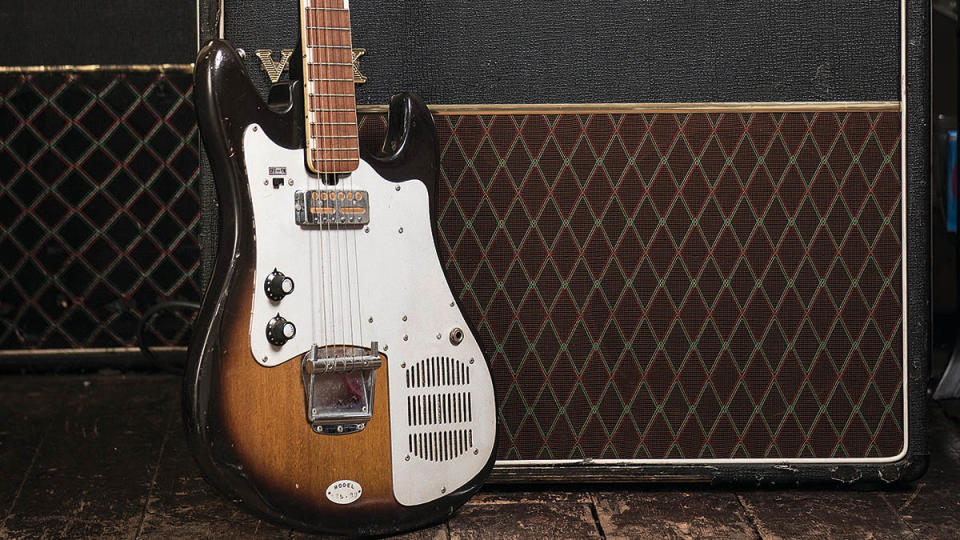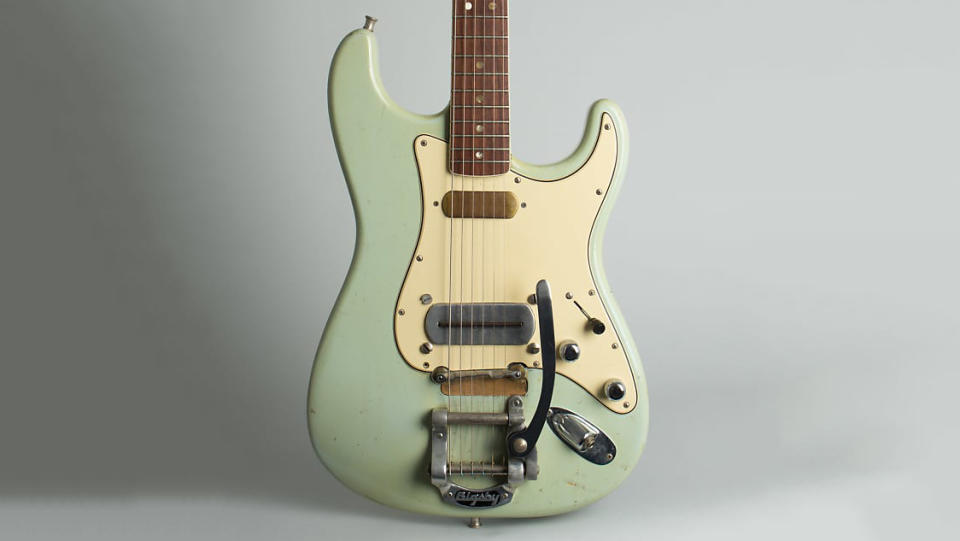They’re loved by St. Vincent, Dan Auerbach and Ry Cooder – but what’s behind the Gold Foil pickup resurgence?

- Oops!Something went wrong.Please try again later.
What is a Gold Foil pickup exactly? Unfortunately, there is no straightforward answer, because the only feature common to all Gold Foil pickups is a layer of textured-foil covered paper or cloth beneath cut-out metal covers. It serves no sonic purpose and is merely there to smarten up the look and keep dirt, sweat and debris away from the coil.
‘Gold Foil’ is really just a catch-all term for a range of pickups that often differ significantly in looks, construction and tone. They weren’t all produced by the same company and vintage examples were made in the US and Japan simultaneously and independently.
As a result, there is much confusion about Gold Foils, compounded by relatively little in the way of historical documentation. Hot on the heels of our review of Fender’s new Gold Foil Telecaster, we decided it was an opportune moment to take a deep dive down the Gold Foil rabbit hole.
Toledo Gold
During the 1950s in Toledo, Ohio, a company called Rowe Industries was manufacturing guitar pickups under the brand name DeArmond. In the early days of amplification, its pickups were often designed to be retrofitted to non-electric guitars. It also supplied pickups for guitar manufacturers to install in their factories.
Until 1957, Gretsch used DeArmond’s high-end Dynasonics but became concerned that the Gretsch brand could be tainted by DeArmond’s lowlier offerings, which featured on various budget Harmony and Silvertone models. From the late ’50s, these pickups were often the types that are now known as Gold Foils.

It’s a generic term because not all DeArmond Gold Foils were created equal. The chrome-plated covers were cut out in various patterns that have since acquired the nicknames Diamond-Grille, Moustache and S-Grille. The reasons are obvious when you look at them.
Although gold paper foil was usually placed under the covers, DeArmond also used silver and black foil. Pickups featuring the latter became known as Blackjacks or Black Foils.
DeArmond used 44 and 45 AWG magnet wire for the coils, which is thinner than the 42 AWG wire typically used by Gibson and Fender, and harder to wind because of its delicate nature.
The smaller gauge also has a higher resistance, so comparing DeArmond Gold Foils like for like with the DCR specs of more conventional pickups can be misleading. DeArmonds reading above around 9kohms probably have 45 AWG wire and you shouldn’t assume that equates to a hot output or a dark tone.

S-Grille and Diamond-Grille DeArmond magnets did vary, but most were ferrite or ceramic and were not always rubberised. In contrast, DeArmond used rubberised ceramic magnets for the Moustache DeArmond and, according to Marc Ransley of Mojo Pickups, the magnets were tapped so the pole screws would go through the magnets themselves.
Since rubberised ceramic magnets are fairly soft, the threads would often wear and the pole screws would fall out. This is similar to the type of magnet used for flexible fridge door magnets. The coils were wound around the magnets, so there was no need for a conventional bobbin. Matt Bascetta of House Of Tone describes the rubberised ferrite magnets as having “a smoother, fuller and warmer response than ceramic”.

Tokyo Gold
It’s hard to believe nowadays, but there was a time when ‘Japanese guitar’ was a pejorative term. In the ’50s and ’60s, electric guitars from Japan tended to be cheap, mass-produced and almost parodic of American designs. Teisco was one of the biggest brand names, and although some of its guitars looked amazing and were decent enough to inspire a cult following, most agree the pickups were their best feature.
There is some debate about which Gold Foil came first – the DeArmond or the Teisco. It has been claimed that Gold Foils appeared on Teisco guitars as early as 1954, but we haven’t been able to corroborate that and the early examples we have seen appear to have gold sparkle plastic under the covers, rather than foil. They are also quite different in shape and size to Teisco’s later versions.
But that isn’t the salient point because significant distinctions between American and Japanese Gold Foils suggest that they were developed independently and the use of gold foil was largely coincidental or simply expedient. To complicate things further, there are various types of Teisco Gold Foil. But the most popular and copied version is the pickup Ry Cooder has in the neck position of his sunburst Coodercaster.
This Gold Foil can be identified by a row of tiny pole screws running along one side of the cover with six ‘dummy’ holes punched into the cover along the other side and two oval cutouts. At first glance you might suspect that it’s a mini-humbucker, but there’s just one coil with its centre line corresponding with two rivets.
The 44AWG coil is wrapped around a rubberised ceramic bar magnet, and since the pole screws are separated from the coil, many assume they’re mostly for show and serve no practical purpose. However, the magnet rests on a steel baseplate, which also accommodates and therefore magnetises the pole screws.
The pole screws don’t have as much tonal influence as those in a PAF-style humbucker or P-90, but they can help to balance out the strings. Since their polarity is opposite to the upside of the coil magnet, it’s claimed they help to make this particular Teisco Gold Foil quieter than most single-coil pickups.

Another type of Gold Foil that is commonly attributed to Teisco may not have been made by this company after all. It’s the version with the pole screws arranged along the cover’s centre line and the round and oval holes positioned on each side. According to authors Craig Campbell and Frank Meyers in a 2017 article for Reverb.com, these Gold Foils were actually manufactured by another Japanese guitar company called Zen-On.
This version has two bar magnets – either rubberised ceramic or Alnico – with 44 AWG magnet wire and a plastic bobbin. The dual-magnet arrangement is similar to a P-90, but P-90 magnets are placed under the coil. In this Gold Foil, the magnets are positioned adjacent to the coil.
Guyatone Gold
Guyatone Gold Foils were also made in Japan and are somewhat rarer and scarcer than the DeArmonds and Teisco versions. According to Marc Ransley, they were made in-house by Guyatone (Tokyo Sound) for use on Guyatone guitars using different magnets and wire to the Teiscos.
Highly regarded and a favourite of UK slide maestro Ramon Goose, it’s the unit Guyatone fitted to its semi-acoustic SG model guitar. The pickup is relatively large with a square cornered cover, a rectangular cutout to display the foil and a row of pole screws along one edge.
A narrower Guyatone Gold Foil pickup with an ‘N’ pattern cover cutout also featured on Guyatone-manufactured Tulio guitars. Marc Ransley tells us these were “the original Japanese Gold Foil, visually inspired by the US- made DeArmonds and designed by Rihei Takashima for the Fujigen Gakki factory”. Their output is lower than other Gold Foils and they had six pole screws running along the edge with a coil wrapped around a ceramic magnet.
Buying Gold

Since these pickups were made by various companies to different designs, it stands to reason that you can hear a range of Gold Foil tones. This is important to understand if you’re considering buying a guitar that’s equipped with Gold Foils or retrofitting Gold Foils into a guitar.
The American-made DeArmond Gold Foils are considered to have a fuller tone, with fatter mids. Some liken them to a P-90 with a more chime-y and open treble response. Ramon Goose describes them as more rock ’n’ roll-sounding than Teiscos and reports that they’re great with overdriven amps and fuzzboxes. If you’re into Dan Auerbach, St Vincent and Jack White, then DeArmond-style Gold Foils are probably your best option.
In contrast, both types of Teisco Gold Foil are characterised by scooped mids, clear bass and sparkling treble with complex harmonic overtones. Players such as Ry Cooder and David Lindley revered their extreme clarity and detail, and considered them superb for clean tones. Ramon Goose describes them as being slightly thinner-sounding with overdrive than DeArmonds but still very cool.
Ramon actually prefers the larger Guyatone Gold Foils because he finds them slightly fuller-sounding than the famous Coodercaster Teisco. He also finds that flat-wound strings team up nicely with Japanese Gold Foil pickups. If you want to hear a variety of Gold Foils in action, it’s worth checking out Ramon’s YouTube channel.
Years ago, going Gold Foil meant putting up with the often less than stellar build quality of downmarket vintage American and Japanese guitars, or yanking out the pickups to install in guitars with superior playability. But due to the surge of interest, there’s no shortage of modern Gold Foils available.
You can choose accurate vintage reissues or a whole range of Gold Foil-inspired pickups that are designed as drop-in replacements for humbuckers, P-90s, Strats, Teles, Jazzmasters and more. With no routing or pickguard modifications necessary, it has never been easier to go gold.
In the UK, there’s no safer bet than Mojo Pickups and its extensive range of Gold Foils. The company even offers replicas of both types of Guyatone as well as more DeArmond and Teisco-inspired versions. In the US, Curtis Novak makes a similarly extensive Gold Foil collection, but many pickup manufacturers now offer one or two options.
However, Ramon Goose makes the interesting point that vintage Gold Foils are no more expensive than the reissue units – and sometimes even cheaper. Some prefer the original Gold Foils, but buying cheaply made vintage pickups isn’t risk-free and you might have to try several before you find a really good one.
With thanks to Marc Ransley of Mojo Pickups , Matt Bascetta of House of Tone Pickups, and Ramon Goose.

